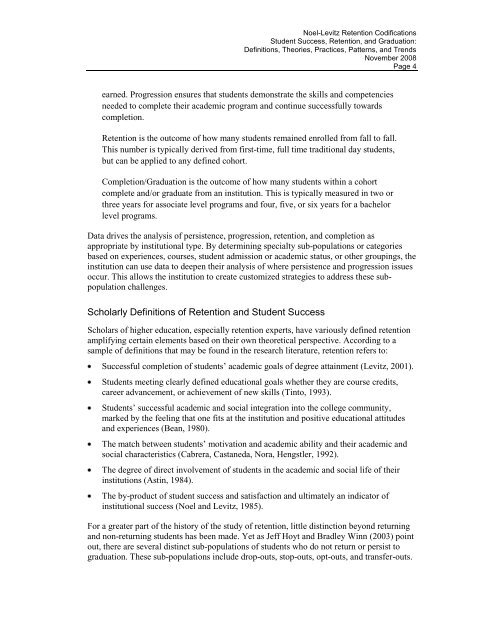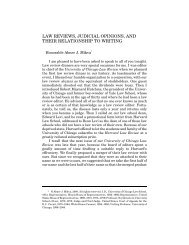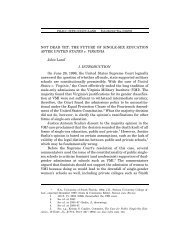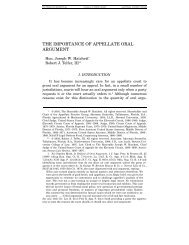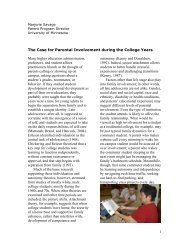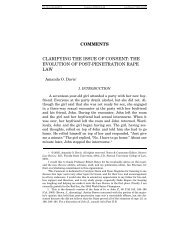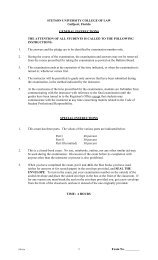Student Success, Retention, and Graduation: Definitions, Theories ...
Student Success, Retention, and Graduation: Definitions, Theories ...
Student Success, Retention, and Graduation: Definitions, Theories ...
You also want an ePaper? Increase the reach of your titles
YUMPU automatically turns print PDFs into web optimized ePapers that Google loves.
Noel-Levitz <strong>Retention</strong> Codifications<strong>Student</strong> <strong>Success</strong>, <strong>Retention</strong>, <strong>and</strong> <strong>Graduation</strong>:<strong>Definitions</strong>, <strong>Theories</strong>, Practices, Patterns, <strong>and</strong> TrendsNovember 2008Page 4earned. Progression ensures that students demonstrate the skills <strong>and</strong> competenciesneeded to complete their academic program <strong>and</strong> continue successfully towardscompletion.<strong>Retention</strong> is the outcome of how many students remained enrolled from fall to fall.This number is typically derived from first-time, full time traditional day students,but can be applied to any defined cohort.Completion/<strong>Graduation</strong> is the outcome of how many students within a cohortcomplete <strong>and</strong>/or graduate from an institution. This is typically measured in two orthree years for associate level programs <strong>and</strong> four, five, or six years for a bachelorlevel programs.Data drives the analysis of persistence, progression, retention, <strong>and</strong> completion asappropriate by institutional type. By determining specialty sub-populations or categoriesbased on experiences, courses, student admission or academic status, or other groupings, theinstitution can use data to deepen their analysis of where persistence <strong>and</strong> progression issuesoccur. This allows the institution to create customized strategies to address these subpopulationchallenges.Scholarly <strong>Definitions</strong> of <strong>Retention</strong> <strong>and</strong> <strong>Student</strong> <strong>Success</strong>Scholars of higher education, especially retention experts, have variously defined retentionamplifying certain elements based on their own theoretical perspective. According to asample of definitions that may be found in the research literature, retention refers to:<strong>Success</strong>ful completion of students’ academic goals of degree attainment (Levitz, 2001).<strong>Student</strong>s meeting clearly defined educational goals whether they are course credits,career advancement, or achievement of new skills (Tinto, 1993).<strong>Student</strong>s’ successful academic <strong>and</strong> social integration into the college community,marked by the feeling that one fits at the institution <strong>and</strong> positive educational attitudes<strong>and</strong> experiences (Bean, 1980).The match between students’ motivation <strong>and</strong> academic ability <strong>and</strong> their academic <strong>and</strong>social characteristics (Cabrera, Castaneda, Nora, Hengstler, 1992).The degree of direct involvement of students in the academic <strong>and</strong> social life of theirinstitutions (Astin, 1984).The by-product of student success <strong>and</strong> satisfaction <strong>and</strong> ultimately an indicator ofinstitutional success (Noel <strong>and</strong> Levitz, 1985).For a greater part of the history of the study of retention, little distinction beyond returning<strong>and</strong> non-returning students has been made. Yet as Jeff Hoyt <strong>and</strong> Bradley Winn (2003) pointout, there are several distinct sub-populations of students who do not return or persist tograduation. These sub-populations include drop-outs, stop-outs, opt-outs, <strong>and</strong> transfer-outs.


